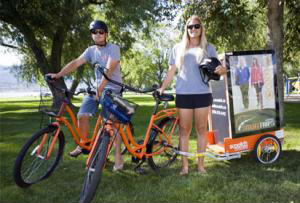Kelowna’s Active Transportation Program: smartTRIPS

Kelowna’s smartTRIPS Program encourages citizens to use non-motorized transportation and transit.
The goal of Kelowna’s smartTRIPS program is to work more directly with residents of a specific neighbourhood to help them to increase biking, walking, transit use, carpooling, and other active transportation options. The program aims to reduce single occupancy driving trips.
Project Summary
Kelowna’s smartTRIPS program is a partnership between the City of Kelowna, Regional District of Central Okanagan, District of West Kelowna, District of Peachland, District of Lake Country and Westbank First Nation developed to address region-wide climate action in the transportation sector. The program encourages residents to reduce the use of personal vehicles and increase the use of active transportation through walking, cycling, and taking transit.
In Spring 2012, Kelowna launched their first neighbourhood trip planning project in Pandosy, the pilot neighbourhood for smartTRIPS neighbourhood program. The program ran for 10 weeks, targeting 1500 households and a small town centre/commercial area. smartTRIPS was based on the community-based social marketing (CBSM) strategy, an innovative approach designed to communicate benefits of a desired activity in addition to identifying and removing barriers which impede a desired long term behavioral change.
The key elements of the Pandosy smartTRIPS program design were: obtaining a commitment from residents, focusing on establishing personal contact to engage citizens rather than distribution of general information, and encouraging residents to actively track changes in their transportation behavior.
The Pandosy pilot involved the following:
- Inviting residents in each household to participate in the program and to request specific resources such as transit guides, cycling and walking maps, bike maintenance and safety guides etc.
- Integrating the program with other existing programs such as Bike to Work and Bike to School Week.
- Encouraging residents to use the proprietary online trip tracking tool to follow number of trips made, km travelled, calories burned and greenhouse gas emissions reduced.
- Adding Kelowna’s city-wide bicycle network to Google Maps to allow residents to plan cycling trips.
- Establishing new partnerships and strengthening existing relationships between local governments and neighbourhood businesses.
- Conducting traffic counts (all modes) at key intersection as well as transit ridership counts at all neighborhood bus stops prior to program implementation in order to further evaluate its impact on mode shift.
- Distributing general transportation survey to all residents in Pandosy prior to the program and one year later, to help gauge program impact on participants and non-participants alike. In addition, participants were sent a survey to evaluate the program.
Pandosy smartTRIPS program evaluation survey results indicate that 50% of participants were using active transportation more than they did prior to the program, and more than 90% said that they would continue to use active transportation.
Energy Savings/GHG reductions
- In the 2011 baseline survey, 55% of respondents reported using motorized vehicles for commuting an average of 12.1km to work/school. One year later, in the 2012 post pilot survey, respondents using a motorized vehicle reduced to 49% and the average commute distance dropped to 7.1km. It is estimated that this represents an overall 47% reduction in VKT to work/school for the neighbourhood.*
- In the 2011 baseline survey, 64% of respondents said they use their car daily, while in 2012 post pilot survey, that number dropped to 57%. This represents an overall reduction of 7% in daily vehicle use.
- For households participating in the program, the primary mode of transportation ‘own vehicle’ reduced from 67% to 64%.
* Please note that this answer was interpolated since combining answers from a few survey questions was the only way to make this calculation!
More than fifty per cent of participants are using active transportation more than they did prior to the program, and more than ninety percent said that they would continue to use active transportation.
Business case
The smartTRIPS program development cost, including the delivery of Pandosy neighbourhood pilot was $58,900, $28.08 per household in the target area. Payback is difficult to calculate but includes increases in transit revenue, and reduced impact on transportation infrastructure (road and parking facility construction costs).
Co-Benefits
In addition to curtailing the greenhouse gas emissions from vehicle travel, reducing noise and air pollution, contributing to improved health and quality of life as well as potential reduced healthcare costs, there are other less direct, potential co-benefits; for example, fostering a stronger sense of community, supporting local area shopping, encouraging community ambassadors for active living, and increasing the visibility of active transportation modes. See report by Victoria Policy Transport Institute the for more information on co-benefits.
Individual Payback
Individuals can calculate vehicle and parking cost savings based on the stats found in the Evaluating Non-Motorized Transportation Benefits and Costs document.
- Average vehicle operating cost savings: $0.225* (cents per reduced motor vehicle-mile)
- Average parking cost savings: $0.360 (cents per reduced motor vehicle-mile)
*Larger savings result if some households can reduce vehicle ownership costs.
Lessons learned
Have a number of specific targets
The program goal to reduce VKT and increase the use of active transportation was very broad. Although some measurable targets were set (eg. 10 -20% reduction in VKT), a greater number of specific targets would have been more useful for the program.
Increase Community visibility
Organize staff attendance at many existing community events, block parties, etc. with an information booth to attract more community participation and awareness.
Local government contact
Mike Kittmer
Active Transportation Coordinator
Regional Services Dept.
T: (250) 469-8531
E: mkittmer@kelowna.ca